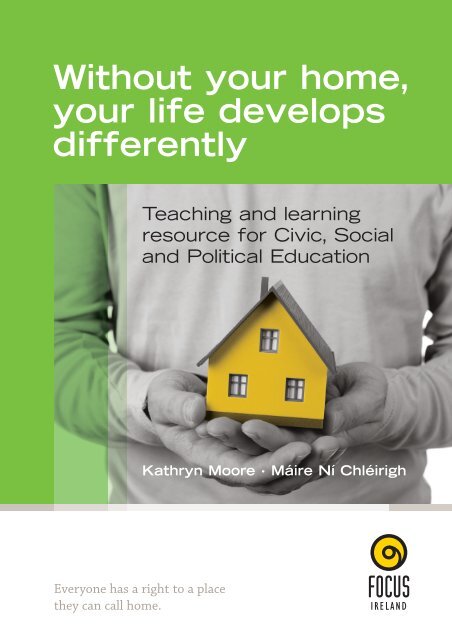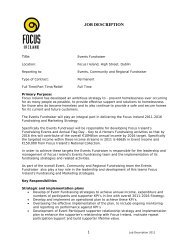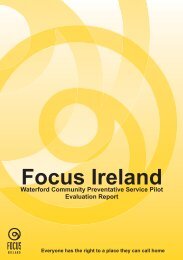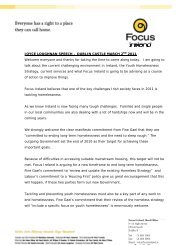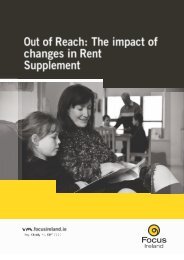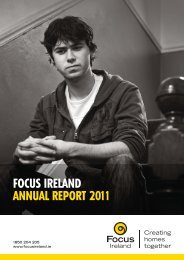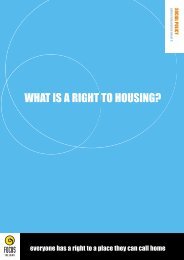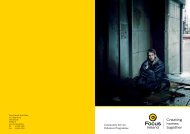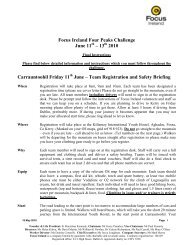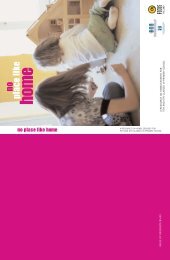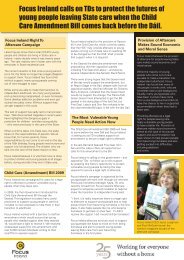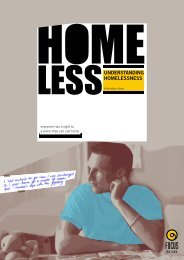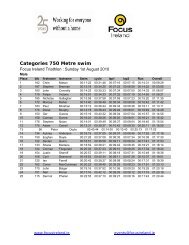CSPE Book Interior - Focus Ireland
CSPE Book Interior - Focus Ireland
CSPE Book Interior - Focus Ireland
You also want an ePaper? Increase the reach of your titles
YUMPU automatically turns print PDFs into web optimized ePapers that Google loves.
Without your home,<br />
your life develops<br />
differently<br />
Teaching and learning<br />
resource for Civic, Social<br />
and Political Education<br />
Kathryn Moore · Máire Ní Chléirigh<br />
Everyone has a right to a place<br />
they can call home.
<strong>Focus</strong> <strong>Ireland</strong> acknowledgements<br />
<strong>Focus</strong> <strong>Ireland</strong> would like to thank the authors Kathryn Moore and Máire Ní Chléirigh and<br />
Conor Harrison of the Curriculum Development Unit of the Dept of Education.<br />
DVD contents<br />
—————————————————————————————————————————————<br />
Lesson 1<br />
Lesson 3<br />
Lesson 5<br />
Lesson 6<br />
Lesson 8<br />
Lesson 9<br />
Photos of various homes<br />
Pictures depicting homelessness<br />
Song: Streets of London<br />
Adverts for <strong>Focus</strong> <strong>Ireland</strong><br />
News item and documentary on the work of <strong>Focus</strong> <strong>Ireland</strong><br />
Photos<br />
Without your home,<br />
your life develops<br />
differently<br />
Teaching and<br />
learning resource<br />
for Civic, Social and<br />
Political Education<br />
Kathryn Moore<br />
Máire Ní Chléirigh<br />
Everyone has a right<br />
to a place they can<br />
call home.<br />
© <strong>Focus</strong> <strong>Ireland</strong> 2009. All<br />
rights<br />
reserved.<br />
Author acknowledgements<br />
We would like to thank the staff and students of St Dominic’s College, Cabra; the staff and<br />
students of Gaelcholáiste Reachrann, Donaghmede; Elaine Byrne, of St Dominic’s College,<br />
Cabra, for sourcing the poetry; Kunak McGann at O’Brien Press for the use of extracts from<br />
Breaking the Wishbone and Bob Harris at Essex Music for the use of ‘Streets of London’.<br />
Thanks also to RTÉ for use of the news report for Lesson 8.
E<br />
D<br />
V<br />
E<br />
CDU<br />
L<br />
C U R R<br />
O<br />
P<br />
I C U<br />
M<br />
E<br />
L U M<br />
N<br />
T<br />
T<br />
U<br />
I<br />
N<br />
Developed by the Curriculum Development Unit<br />
of the Dept of Education in conjunction with <strong>Focus</strong> <strong>Ireland</strong><br />
Contents<br />
Subject Methodology Page<br />
—————————————————————————————————————————————<br />
Lesson 1 Define ‘home’ Brainstorm 2<br />
—————————————————————————————————————————————<br />
Lesson 2 Define ‘homelessness’ Work stations 9<br />
—————————————————————————————————————————————<br />
Lesson 3 Reasons for homelessness Group work 16<br />
—————————————————————————————————————————————<br />
Lesson 4 Case studies Giant steps 20<br />
—————————————————————————————————————————————<br />
Lesson 5 Portrayal of homelessness Newspaper headlines, 28<br />
in the media – 1<br />
song, poem, novel extract<br />
—————————————————————————————————————————————<br />
Lesson 6 Portrayal of homelessness Three TV adverts 34<br />
in the media – 2<br />
for <strong>Focus</strong> <strong>Ireland</strong><br />
—————————————————————————————————————————————<br />
Lesson 7 A day in the life of a Role-play 38<br />
person who is homeless<br />
—————————————————————————————————————————————<br />
Lesson 8 Work of <strong>Focus</strong> <strong>Ireland</strong> News item, DVD on 41<br />
work of <strong>Focus</strong> <strong>Ireland</strong><br />
—————————————————————————————————————————————<br />
Lesson 9 Concept of human dignity Photographs 43<br />
—————————————————————————————————————————————<br />
Lesson 10 Simulation of an Simulation 45<br />
action project<br />
—————————————————————————————————————————————<br />
Exam-style questions 53<br />
Everyone has a right to a place<br />
they can call home.
Lesson 1<br />
Define ‘home’<br />
Learning outcomes<br />
Requirements<br />
> Photos of types of homes<br />
> Worksheets for each student<br />
Students will be able to define the concept<br />
of home and broaden that vision.<br />
Note to teacher<br />
The following activity may bring up issues<br />
for some students, where home may not<br />
necessarily be a happy place.<br />
Step 1<br />
Pose the question: What does home mean<br />
to you? Ask the students to list words, both<br />
positive and/or negative, that define home<br />
for them. Put these words on the board.<br />
Discuss the words, asking students<br />
whether they agree with all the words<br />
chosen. Ask the students if there are any<br />
words which they would not use to<br />
describe home, or if there are any words<br />
which surprise them and why. (10 mins)<br />
Step 2<br />
Having thought about the meaning of<br />
home, ask students to draw an<br />
outline/sketch of the image that comes to<br />
them when they think about home. Ask a<br />
number of students to briefly present and<br />
explain their image. (10 mins)<br />
Step 3<br />
Present students with pictures of various<br />
types of homes (pages 5–8; also available<br />
on DVD). Ask which images do not<br />
conform to their view of home. (5 mins)<br />
Step 4<br />
Ask the students to work in pairs and to<br />
agree on and complete their definition of<br />
home, beginning with the words: ‘Home is ...’<br />
Ask students to read out their definitions.<br />
(10 mins)<br />
Step 5 Homework<br />
Hand out Worksheet A and introduce/<br />
discuss the four logos shown on the sheet.<br />
Ask the students to complete the worksheet<br />
at home and to write a name and design a<br />
logo for a homeless organisation<br />
(Worksheet B). (5 mins)<br />
Teacher’s notes<br />
Explain the symbolism of the four logos on<br />
the worksheet. Information can be found on<br />
the following websites:<br />
www.focusireland.ie<br />
www.makeroom.ie<br />
www.threshold.ie<br />
www.simoncommunity.com<br />
2 Lesson 1 · Define ‘home’
photocopy<br />
✓<br />
Lesson 1 · Worksheet A<br />
Here are logos used by organisations working to combat and prevent homelessness.<br />
Study the logos and give one reason why each logo was chosen.<br />
_____________________________________________<br />
_____________________________________________<br />
_____________________________________________<br />
_____________________________________________<br />
_____________________________________________<br />
_____________________________________________<br />
_____________________________________________<br />
_____________________________________________<br />
_____________________________________________<br />
_____________________________________________<br />
_____________________________________________<br />
_____________________________________________<br />
_____________________________________________<br />
_____________________________________________<br />
_____________________________________________<br />
_____________________________________________<br />
_____________________________________________<br />
_____________________________________________<br />
_____________________________________________<br />
_____________________________________________<br />
Lesson 1 · Define ‘home’<br />
3
photocopy<br />
✓<br />
Lesson 1 · Worksheet B<br />
In this box, write a name and design a logo for a homeless organisation.<br />
4 Lesson 1 · Define ‘home’
Lesson 1 · Photo 1<br />
photocopy<br />
✓<br />
Lesson 1 · Photo 2<br />
Lesson 1 · Define ‘home’<br />
5
Lesson 1 · Photo 3<br />
photocopy<br />
✓<br />
Lesson 1 · Photo 4<br />
6 Lesson 1 · Define ‘home’
Lesson 1 · Photo 5<br />
photocopy<br />
✓<br />
Lesson 1 · Photo 6<br />
Lesson 1 · Define ‘home’<br />
7
Lesson 1 · Photo 7<br />
photocopy<br />
✓<br />
Lesson 1 · Photo 8<br />
8 Lesson 1 · Define ‘home’
Lesson 2<br />
Define ‘homelessness’<br />
Learning outcomes<br />
Requirements<br />
Students will be able to define what it<br />
means to be homeless.<br />
> Blu-Tack<br />
> Four blank banners<br />
> A4 fact sheets<br />
> Double-sided copy<br />
of worksheet for<br />
each student<br />
Step 1<br />
Ask the students to write a definition of<br />
homelessness. While students are working,<br />
make four work stations by hanging four A2<br />
fact posters around the room. Divide the<br />
class into four groups. (5 mins)<br />
Step 2<br />
Ask each group to stand at one of the four<br />
work stations. Tell the groups that they will<br />
have five minutes at each station. Ask them<br />
to appoint someone to read through the<br />
facts for the group. As a group they must<br />
choose one of the given facts and the most<br />
surprising fact to write on the worksheet,<br />
Side 1. (The facts may be written in the<br />
students’ own words.)<br />
Step 3<br />
Ask students to rotate in a clockwise<br />
direction to the next station every five<br />
minutes, until each group has visited each<br />
station and the same task has been<br />
completed at each. (20 mins in total)<br />
Step 4<br />
Ask students to pick one fact from their<br />
worksheet and make a headline banner<br />
with that fact. Get each group to present<br />
their fact. (10 mins)<br />
Step 5<br />
Ask the students to re-read their definition<br />
of homelessness (Step 1) and to complete<br />
the first section of side 2 of the worksheet.<br />
Ask them if their understanding of<br />
homelessness has now changed. Then ask<br />
them to complete the second section of the<br />
worksheet at home.<br />
An optional ending to this lesson is to tell<br />
the students about famous people who<br />
have experienced homelessness:<br />
Tupac Shakur, singer<br />
George Orwell, author<br />
Jim Carrey, actor<br />
Li’l Kim, singer<br />
Halle Berry, actress<br />
Lesson 2 · Define ‘homelessness’<br />
9
photocopy<br />
✓<br />
Lesson 2 · Factsheet 1<br />
Things you might not know<br />
about homelessness<br />
<strong>Ireland</strong> had a team playing in the<br />
Homeless Soccer World Cup in<br />
South Africa, Scotland and<br />
Denmark in recent years.<br />
London-Irish author John Healy won<br />
international awards for the book he<br />
wrote called ‘The Grass Arena’<br />
about the years he was homeless.<br />
Popular Dublin stand-up comedian<br />
Willa White was once homeless.<br />
A man who was homeless won an<br />
award for bravery for rescuing a<br />
bus driver from drowning in the<br />
river Liffey in Dublin.<br />
The music group The <strong>Focus</strong> Beats<br />
who were all homeless released a<br />
Christmas CD to raise money for<br />
<strong>Focus</strong> <strong>Ireland</strong>.<br />
10 Lesson 2 · Define ‘homelessness’
photocopy<br />
✓<br />
Lesson 2 · Factsheet 2<br />
Youth homelessness<br />
Nearly 500 children under 18 years<br />
of age* who were homeless were<br />
not in the care of a parent or family<br />
member (*HSE/DHC 2006).<br />
Many young people drop out of<br />
school when they become homeless.<br />
Children living in families who are<br />
homeless often have to move away<br />
from their local area to stay in<br />
emergency accommodation.<br />
Young people leaving State care face<br />
a high risk of becoming homeless.<br />
The State has a legal requirement to<br />
provide accommodation for anyone<br />
under 18 years of age.<br />
Young people who are homeless<br />
face a high risk of becoming<br />
addicted to drugs or falling victim to<br />
exploitation by others.<br />
Lesson 2 · Define ‘homelessness’<br />
11
photocopy<br />
✓<br />
Lesson 2 · Factsheet 3<br />
Impact of homelessness<br />
Children who are homeless and<br />
living in emergency accommodation<br />
often have nowhere safe to play.<br />
Living in a disadvantaged area<br />
increases the risk of homelessness.<br />
Many young people drop out of<br />
school when they become homeless.<br />
People living in poverty are at a<br />
greater risk of living in poor housing.<br />
People who are homeless find it<br />
difficult to get a job as they have<br />
no permanent address.<br />
12 Lesson 2 · Define ‘homelessness’
photocopy<br />
✓<br />
Lesson 2 · Factsheet 4<br />
Health and homelessness<br />
People who are homeless often have<br />
great difficulty accessing health services.<br />
A previous report by the National<br />
Advisory Committee On Drugs<br />
found that 90% of people<br />
experiencing homelessness had a<br />
physical health complaint and that<br />
48% reported concerns regarding<br />
their psychiatric health.<br />
Many people who are homeless are at a<br />
higher risk of becoming addicted to<br />
drugs and/or alcohol as they attempt to<br />
escape their problems.<br />
The average age of death of<br />
someone sleeping rough is 42 years.<br />
The average age of death for the<br />
Irish male is 78 years.<br />
Mental health problems are a major<br />
cause of homelessness.<br />
Lesson 2 · Define ‘homelessness’<br />
13
photocopy<br />
✓<br />
Lesson 2 · Worksheet A · Side 1<br />
After your visit to each station write a fact and a surprising fact about each of<br />
the four headings below:<br />
————————————————————————————————————————<br />
Things you might not know about homelessness:<br />
Fact<br />
Surprising fact<br />
————————————————————————————————————————<br />
Youth homelessness:<br />
Fact<br />
Surprising fact<br />
————————————————————————————————————————<br />
Impact of homelessness:<br />
Fact<br />
Surprising fact<br />
————————————————————————————————————————<br />
Health and homelessness:<br />
Fact<br />
Surprising fact<br />
14 Lesson 2 · Define ‘homelessness’
photocopy<br />
✓<br />
Lesson 2 · Worksheet A · Side 2<br />
Homework<br />
————————————————————————————————————————<br />
You have been presented with these facts. Now has your definition of<br />
homelessness changed? State how.<br />
————————————————————————————————————————<br />
Why/Why not?<br />
Lesson 2 · Define ‘homelessness’<br />
15
Lesson 3<br />
Reasons for homelessness<br />
Learning outcomes<br />
Requirements<br />
To investigate the reasons people<br />
become homeless.<br />
> Copy of pictures from DVD<br />
> Nine role outlines<br />
Step 1<br />
Show the class the pictures (on DVD) of<br />
people and ask the students to state the<br />
different reasons they think they may have<br />
become homeless.<br />
Try to elicit the following reasons:<br />
> Family breakdown<br />
> Mental health problems/illness<br />
> Domestic violence<br />
> Abuse<br />
> Leaving institutions:<br />
State care homes, prisons,<br />
psychiatric hospitals<br />
> Alcohol/drug misuse and addiction<br />
> Poverty/loss of employment/debts<br />
> Eviction<br />
> Lack of adequate social housing<br />
Step 3<br />
Role play the TV show. The host asks<br />
the characters to discuss how the<br />
following issues affect each one of them:<br />
health issues, education, employment,<br />
relationships, social skills, poverty,<br />
immigration.<br />
Step 4<br />
The rest of the students may wish to<br />
ask questions of the panel according to<br />
the answers they hear. Encourage<br />
student participation.<br />
Step 5<br />
For homework ask the students to write a<br />
story or a newspaper article about one of<br />
the interviewees.<br />
Step 2<br />
Ask nine students to prepare a role based<br />
on one of the nine characters presented in<br />
the role outlines. Ask them to fill in what<br />
they think is a suitable age and location for<br />
their character. They will be members of a<br />
TV panel, answering questions asked by<br />
the host/teacher.<br />
16 Lesson 3 · Reasons for homelessness
Lesson 3 · Roles outlines<br />
photocopy<br />
✓<br />
Name<br />
John<br />
————————————————————————————————<br />
Age<br />
————————————————————————————————<br />
Location<br />
————————————————————————————————<br />
Reason for<br />
Family breakdown<br />
becoming homeless<br />
Name<br />
Ciarán<br />
————————————————————————————————<br />
Age<br />
————————————————————————————————<br />
Location<br />
————————————————————————————————<br />
Reason for<br />
Lost job<br />
becoming homeless<br />
Name<br />
Vincent<br />
————————————————————————————————<br />
Age<br />
————————————————————————————————<br />
Location<br />
————————————————————————————————<br />
Reason for<br />
Drug addiction<br />
becoming homeless<br />
Name<br />
Paul<br />
————————————————————————————————<br />
Age<br />
————————————————————————————————<br />
Location<br />
————————————————————————————————<br />
Reason for<br />
No home since leaving State care at the age<br />
becoming homeless of 18 as all young people in care have to do.<br />
Name<br />
Aoife<br />
————————————————————————————————<br />
Age<br />
————————————————————————————————<br />
Location<br />
————————————————————————————————<br />
Reason for<br />
Suffered mental health problems;<br />
becoming homeless lost her flat as she didn’t keep up rent<br />
payments and has not had a home since<br />
her last hospital stay.<br />
Lesson 3 · Reasons for homelessness<br />
17
Lesson 3 · Roles outlines<br />
photocopy<br />
✓<br />
Name<br />
Magda<br />
————————————————————————————————<br />
Age<br />
————————————————————————————————<br />
Location<br />
————————————————————————————————<br />
Reason for<br />
Left her home because she was<br />
becoming homeless the victim of domestic violence.<br />
Name<br />
Baiba<br />
————————————————————————————————<br />
Age<br />
————————————————————————————————<br />
Location<br />
————————————————————————————————<br />
Reason for<br />
Came to <strong>Ireland</strong> from Poland two<br />
becoming homeless years ago. She lost her job six months ago<br />
and then lost her rented flat. She has lived in<br />
emergency accommodation since then.<br />
Name<br />
Rebecca<br />
————————————————————————————————<br />
Age<br />
————————————————————————————————<br />
Location<br />
————————————————————————————————<br />
Reason for<br />
Ran away from home because<br />
becoming homeless of problems with her family.<br />
Name<br />
Susan, Paul and their<br />
son Johnny<br />
———————————————————————————<br />
Age<br />
———————————————————————————<br />
Location<br />
———————————————————————————<br />
Reason for<br />
Became homeless when Paul<br />
becoming homeless lost his job as a builder and they<br />
couldnt keep up rent payments<br />
on their apartment and the<br />
family were evicted.<br />
18 Lesson 3 · Reasons for homelessness
Teachers notes: causes of homelessness<br />
Homelessness is a complex issue and there is often not just one simple explanation<br />
for a person finding him or herself without a home. <strong>Focus</strong> <strong>Ireland</strong> believes it is vital to<br />
understand the wide range of issues that may lead to a family or single person<br />
becoming homeless in order to prevent homelessness and to provide relevant<br />
services to people out-of-home.<br />
There are many different pathways into homelessness and there is usually more<br />
than one reason for an individual becoming homeless. Homelessness is more than<br />
the result of individual issues. It can often involve a complex interrelationship of<br />
social, economic and individual factors. Structural causes (such as the lack of<br />
enough social housing and poor access to private rented accommodation for people<br />
on welfare/low incomes) must be considered, not only to meet the needs of a person<br />
out of home, but also to address factors leading to homelessness. There are up to<br />
5,000 people who are homeless in <strong>Ireland</strong> at any one time. A small percentage of<br />
this number sleeps rough on the streets, with the majority staying in emergency<br />
accommodation (such as hostels and Bed & Breakfasts) on a night-by-night basis.<br />
The following are some of the many reasons that can<br />
lead to people becoming homeless:<br />
> Family breakdown<br />
> Mental health problems/illness<br />
> Domestic violence<br />
> Abuse<br />
> Leaving institutions: State care homes, prisons, psychiatric hospitals<br />
> Alcohol/drug misuse and addiction<br />
> Poverty/loss of employment/debts<br />
> Eviction<br />
> Not enough social housing provided by the State for people who need a home<br />
Lesson 3 · Reasons for homelessness<br />
19
Lesson 4<br />
Case studies<br />
Learning outcomes<br />
To get students to identify with people<br />
who are homeless.<br />
Requirements<br />
> Ten case studies; paste copies of<br />
each on to card, ensuring every<br />
student has one<br />
> List of statements to be read<br />
> Definitions of terms used in the<br />
case studies<br />
Step 1<br />
Distribute one case study to every student<br />
(there are ten different case studies).<br />
Ensure students keep theirs private. Each<br />
student should imagine they are the person<br />
described in the case study. (5 mins)<br />
Step 2<br />
Students line up at the back of the room<br />
while statements are read out. Tell students<br />
they can take a full stride forward if they<br />
can achieve the statement without difficulty;<br />
if they are unsure they can take a small<br />
step; if they are sure their character cannot<br />
achieve the statement they stay still.<br />
Teacher reads out statements. (10 mins)<br />
Step 3<br />
When completed, ask students how they<br />
feel about where they are now positioned.<br />
Ask which statements caused most to be<br />
held back. Begin a discussion between<br />
students who had the same case study but<br />
may have ended up in different places,<br />
particularly those who had case studies for<br />
the same person but at different stages in<br />
that person’s life. (10 mins)<br />
Note to teacher<br />
There are five people referred to in the ten<br />
case studies. Each person is referred to in<br />
two case studies, one outlining their lives<br />
while still homeless. The second case<br />
study outlines the same circumstances<br />
but it also includes the details explaining<br />
how they eventually got their own home.<br />
Do not alert the students to this difference<br />
in the information in the case studies.<br />
Step 4<br />
Ask students to consider the different<br />
situations these people found themselves<br />
in, e.g. some were on the streets, some in<br />
squats, some in hostels. On the board<br />
give the definition of the three levels of<br />
homelessness: visible, hidden, at risk.<br />
Ask students to consider which applies to<br />
their case study and to share this with the<br />
class (see p. 26). (10 mins)<br />
Step 5<br />
List the services referred to in the case<br />
studies, asking the class to brainstorm what<br />
the service consists of before giving the<br />
specific definition (see p. 27). (5 mins)<br />
Step 6<br />
As a homework activity, ask students to<br />
choose one of the services which are open<br />
to people who are homeless. They must<br />
write a short news report describing and<br />
promoting the work of the service.<br />
20 Lesson 4 · Case studies
Lesson 4 · Case studies<br />
photocopy<br />
✓<br />
Frankie, 19<br />
I became homeless when I had to leave State care at the age of 18. I was in care as<br />
my family broke up and my mum wasn’t able to cope with things. It’s the same for<br />
everyone in care once you are 18. I had to leave the home I was living in with other<br />
kids and I was straight into a hostel. I didn’t like it at all. Some people were using<br />
drugs and I had some of my things robbed when I was asleep. I just didn’t feel safe.<br />
I ended up sleeping on the streets and that was horrible. I had to beg to get money<br />
for food and I felt most people were looking down on me when they walked by. I just<br />
felt totally lost and alone. Then one day I met a street outreach worker from <strong>Focus</strong><br />
<strong>Ireland</strong>. I went down to <strong>Focus</strong> <strong>Ireland</strong>’s Extension service (a drop in centre for young<br />
people) with him to get off the streets for a bit. He told me about <strong>Focus</strong> <strong>Ireland</strong>’s<br />
accommodation for young people who have left State care. I didn’t know anything<br />
about it. They work with people before they leave care and make sure they have<br />
somewhere to go to live with staff to support them. I was lucky enough to get a place<br />
and have been here 10 months now. My support worker helped me to get into a<br />
course. Eventually I will be ready to move into my own place. I love it here and it will<br />
be great when I get my own place.<br />
<br />
Frankie, 19<br />
I became homeless when I had to leave State care at the age of 18. I was in care as<br />
my family broke up and my mum wasn’t able to cope with things. It’s the same for<br />
everyone in care once you are 18. I had to leave the home I was living in with other<br />
kids and I was straight into a hostel. I didn’t like it at all. Some people were using<br />
drugs and I had some of my things robbed when I was asleep. I just didn’t feel safe.<br />
I ended up sleeping on the streets and that was horrible. I had to beg to get money<br />
for food and I felt most people were looking down on me when they walked by. I just<br />
felt totally lost and alone.<br />
Lesson 4 · Case studies<br />
21
Lesson 4 · Case studies<br />
photocopy<br />
✓<br />
Caroline, 30, and Ross, 1<br />
I spent practically all of my life sleeping on the streets, or anywhere I could find.<br />
I lived in hostels since I was 14 years old. When Ross was born I didn’t want to<br />
take him to a hostel. When he was three days old, we were sent to a mother and<br />
baby unit. The unit was lovely and clean and I didn’t want to leave. I felt safe there.<br />
The staff showed me how to look after Ross and they gave me the support I<br />
needed. Now we live in <strong>Focus</strong> <strong>Ireland</strong>’s long-term housing. Ross went to the<br />
crèche and is now preparing for school.<br />
Caroline, 30, and Ross, 1<br />
I spent practically all of my life sleeping on the streets, or anywhere I could find. I<br />
lived in hostels since I was 14 years old. When Ross was born I didn’t want to take<br />
him to a hostel. When he was three days old, we were sent to a mother and baby<br />
unit. The unit was lovely and clean and I didn’t want to leave. I felt safe there.<br />
22 Lesson 4 · Case studies
Lesson 4 · Case studies<br />
photocopy<br />
✓<br />
Brian, 28<br />
I started using drugs when I was a teenager. My family were very annoyed with me<br />
when I got addicted to drugs. In the end my Ma asked me to leave. When I was<br />
homeless I slept in an old school. I used to sneak back home in through the back<br />
door. I had a shower and got something to eat. I took drugs because I was so quiet<br />
and I thought I was no good. The drugs wrecked my head. When I was on drugs I<br />
was always around people I didn’t like. I trusted nobody. Keltoi is a detox centre and<br />
they helped me to get off drugs. I knew I had to stay away from the gang back home<br />
if I was going to stop using. I moved into <strong>Focus</strong> <strong>Ireland</strong>’s Step-Down Programme<br />
where I have a key worker, Scarlett. I’m taught how to look after myself and to know<br />
my rights as a tenant. I pay my own bills and do my own cooking. I’m also near to my<br />
Narcotics Anonymous meetings and I get all the support I need from staff at <strong>Focus</strong><br />
<strong>Ireland</strong> to help me stay clean from drugs. I’m now studying addiction skills and I want<br />
to become an outreach worker. For the first time in my life I really believe I have a<br />
future. I really believe in myself and that I can achieve good things in life. I want to<br />
use my tough experiences to help other people.<br />
<br />
Brian, 28<br />
I started using drugs when I was a teenager. My family were very annoyed with me<br />
when I got addicted to drugs. In the end my Ma asked me to leave. When I was<br />
homeless I slept in an old school. I used to sneak back home in through the back<br />
door. I had a shower and got something to eat. I took drugs because I was so quiet<br />
and I thought I was no good. The drugs wrecked my head. When I was on drugs I<br />
was always around people I didn’t like. I trusted nobody.<br />
Lesson 4 · Case studies<br />
23
Lesson 4 · Case studies<br />
photocopy<br />
✓<br />
John, 45<br />
I was on the streets after separating from my wife. I was sleeping rough here and<br />
there, anywhere I could get my head down. Then I was referred to the <strong>Focus</strong> <strong>Ireland</strong><br />
transitional housing programme in George’s Hill. It’s brilliant here. There are rules, of<br />
course, I abide by them and they help you as much as they can. I learn the skills I<br />
need for living alone: cooking, decorating and so on. Staff also work to support me to<br />
overcome any problems I have and make me feel better when I am struggling to<br />
cope. I hope to be able to move to independent living soon. The Tenancy Support and<br />
Settlement Team will work with me after I move to make sure that I’ll settle in to my<br />
new home and my new community.<br />
John, 45<br />
I was on the streets after separating from my wife. I was sleeping rough here and<br />
there, anywhere I could get my head down.<br />
24 Lesson 4 · Case studies
Lesson 4 · Case studies<br />
photocopy<br />
✓<br />
Maureen, 32<br />
I have three children, aged from 2 to 5 years old. My husband became increasingly<br />
violent towards us, so I took the children and went to a refuge. We lived in the refuge<br />
for a good while before moving into one of <strong>Focus</strong> <strong>Ireland</strong>’s houses in Waterford. The<br />
staff helped me to go to childcare classes. They also worked with me to teach me the<br />
skills to do things like keep on top of my bills and how to budget my money. My<br />
husband used to control everything before this so I wasn’t use to dealing with money<br />
at all. I had never been shown how to, even when I was growing up in my own family.<br />
I’m now saving for a small car so that I can drive to see my mother. It will be great as<br />
I haven’t seen her in years. My husband never let me see her. The baby is in the<br />
crèche here at <strong>Focus</strong> <strong>Ireland</strong>; my other two children are in the Homework Club, so I<br />
know their homework is always done. We all feel safe here.<br />
Maureen, 32<br />
I have three children, aged from 2 to 5 years old. My husband became increasingly<br />
violent towards us, so I took the children and went to a refuge.<br />
Lesson 4 · Case studies<br />
25
Statements<br />
> I feel safe.<br />
> I am happy.<br />
> I am afraid.<br />
> I/my children can go to school.<br />
> I have a good social life and can meet up with my friends whenever I want.<br />
> I live with my family.<br />
> I am looking forward to the future.<br />
> When I am sick, I can go to a doctor.<br />
> I have enough to eat and drink.<br />
> I can get a good job.<br />
> I can travel without difficulty.<br />
Definitions of terms used in the case studies<br />
Levels of homelessness<br />
Visible<br />
People sleeping rough and/or those accommodated in emergency hostels,<br />
or private emergency accommodation.<br />
Hidden<br />
People who are involuntarily sharing with family or friends and/or people living in<br />
substandard living conditions.<br />
At risk<br />
People who currently have housing but could possibly become homeless due to<br />
economic difficulties, job losses, insecure tenure, not being able to keep up<br />
paying rent/mortgage payments, leaving State care, illness, or living with mental<br />
health difficulties.<br />
Frankie Family breakdown Visible<br />
—————————————————————————————<br />
Frankie Family breakdown Visible<br />
—————————————————————————————<br />
Caroline Family breakdown Hidden<br />
—————————————————————————————<br />
Brian Addiction Hidden<br />
—————————————————————————————<br />
John Family breakdown Visible<br />
—————————————————————————————<br />
Maureen Domestic abuse At risk<br />
26 Lesson 4 · Case studies
Some of the services available to people who<br />
are homeless or at risk of becoming homeless<br />
Tenancy Support and Settlement Team<br />
A team of staff that works with families and<br />
single people at risk of becoming homeless to<br />
ensure they sustain their tenancy and settle in<br />
as part of their local community.<br />
Key worker<br />
A person from an organisation like <strong>Focus</strong><br />
<strong>Ireland</strong> who works with people who are<br />
homeless to support them step by step to<br />
get – and keep – a home and overcome other<br />
problems they may have, so they do not<br />
become homeless again in the future.<br />
Homework Club<br />
An after-school service working with children of<br />
families who are homeless and living in<br />
temporary accommodation. This service helps<br />
support children to keep up their education<br />
and stay in school.<br />
Supported Housing<br />
Many people who are homeless need support in<br />
order to live as independently as possible in<br />
their home. Without this support people can get<br />
trapped in a repeat cycle of homelessness.<br />
<strong>Focus</strong> <strong>Ireland</strong> staff work to support people to<br />
sustain their home and manage difficulties they<br />
may have to help them to move towards<br />
independent living. However, some people will<br />
need this support on a permanent basis as they<br />
may have on-going issues including health,<br />
disability, or mental health issues that could put<br />
them at risk of becoming homeless again if they<br />
did not have support as required.<br />
<strong>Focus</strong> <strong>Ireland</strong>’s Off-the-Streets Project<br />
Provides short-term accommodation and<br />
support to young people between the ages of 16<br />
and 18. The young people are encouraged to<br />
deal with the issues that led to them becoming<br />
homeless. <strong>Focus</strong> <strong>Ireland</strong> staff support them to<br />
overcome these problems and to take up<br />
training and education programmes that will<br />
help them move on with their lives.<br />
Young people’s Aftercare Programme<br />
<strong>Focus</strong> <strong>Ireland</strong> has called for a legal right to<br />
aftercare. The current situation is that once a<br />
young person in State care becomes 18 they<br />
have to leave. If there was a legal right to<br />
aftercare this would mean that people leaving<br />
State care at 18 would have to be provided with<br />
somewhere to live in a supported environment<br />
for at least a year after leaving care to help them<br />
make a successful transition to independent<br />
adult life and prevent them from becoming<br />
homeless. <strong>Focus</strong> <strong>Ireland</strong> staff work with young<br />
people at their aftercare project in Dublin where<br />
they are encouraged to participate in training to<br />
support the further development of life skills,<br />
build their confidence and also undertake<br />
education and work programmes to enable<br />
them to move on to independent living.<br />
The Outreach and Extension Team<br />
This team works both on the street and in the<br />
Extension day service. The Street Outreach<br />
Team works with people who are sleeping<br />
rough, building relationships with them and<br />
helping them to move away from the streets by<br />
encouraging them to use other services that will<br />
help them out of homelessness. The Extension<br />
Service provides support and practical facilities,<br />
including laundry and showers for young people<br />
aged between 16 and 25 years.<br />
Refuge<br />
A refuge usually refers to a women’s refuge<br />
which provides safe accommodation for women<br />
– and their families – who are suffering<br />
domestic violence, which can be one of the<br />
causes of homelessness.<br />
Step-Down Programme<br />
A short-term housing programme run by <strong>Focus</strong><br />
<strong>Ireland</strong> to support people who have successfully<br />
completed a drug rehabilitation programme to<br />
help them stay off drugs and learn the skills<br />
needed to prepare for independent living clean<br />
from drugs into the future.<br />
Lesson 4 · Case studies<br />
27
Lesson 5<br />
Portrayal of homelessness<br />
in the media – 1<br />
Learning outcomes<br />
Requirements<br />
> Four different handouts, one for<br />
each group<br />
> Recording of the song ‘Streets of<br />
London’ (DVD)<br />
To have students explore representations<br />
of people who are homeless in various<br />
media. In this lesson, the media to be<br />
explored are poetry, song, newspapers<br />
and fiction.<br />
Poetry, song, newspapers and fiction<br />
Step 1<br />
Ask students to consider how people<br />
who are homeless are viewed by many<br />
people in society. Are there certain<br />
images associated with homelessness?<br />
Are they correct? (10 mins)<br />
Step 2<br />
Divide the students into four groups. Give<br />
each group a different handout.<br />
> Handout 1 is a poem (three poems are<br />
provided; the teacher may choose the<br />
most suitable, depending on age and<br />
ability of the students).<br />
> Handout 2 is the lyrics of ‘Streets<br />
of London’.<br />
> Handout 3 is newspaper headlines.<br />
> Handout 4 is an extract from the<br />
novel Breaking the Wishbone,<br />
by Siobhán Parkinson.<br />
(5 mins).<br />
Step 3<br />
Ask each group to read their handout and<br />
consider the image of homelessness<br />
portrayed. Ask the students to write four<br />
points about the media portrayal of people<br />
who are homeless and to state whether or<br />
not these are accurate. (15 mins)<br />
Step 4<br />
Take feedback from the class. (5–10 mins)<br />
Step 5<br />
Finish the class by playing the song ‘Streets<br />
of London’ (on DVD).<br />
28 Lesson 5 · Portrayal of homelessness in the media – 1
photocopy<br />
✓<br />
Lesson 5 · Handout 1<br />
This poem was written by a young person who was supported by <strong>Focus</strong> <strong>Ireland</strong><br />
to move on from homelessness.<br />
Being Homeless<br />
Being homeless is limbo to some …<br />
No work, but early starts …<br />
Nothing to do, all the time in the world!<br />
Nowhere to go, the world is your oyster.<br />
No money, but wealthy in conversation.<br />
No peers, but friends are in the same dilemma.<br />
No hope, hope for others.<br />
No change, we’re changing every day.<br />
No home, home’s where you make it –<br />
Even when I’m home, in my heart I’ll always remember being homeless.<br />
Lesson 5 · Handout 1<br />
This poem was written by a young person who was supported by <strong>Focus</strong> <strong>Ireland</strong><br />
to move on from homelessness.<br />
What Home Means to Me<br />
Some people wouldn’t be able to relate to my idea of home.<br />
Everyone is different. Having a good atmosphere.<br />
Sitting down and talking about stuff.<br />
My view of a home is where my friends come to see me.<br />
It’s where I eat, and that’s where I have the craic with my friends when they come<br />
around. That’s what I call l home. Somewhere I can call mine.<br />
Getting a place, I found it fairly easy looking after myself ’cos I can cook for myself.<br />
But you can take it for granted, having a place. You can end up back on the<br />
street quicker than lightning.<br />
And there’s a chain of events that leads back to being homeless, whether it’s<br />
spending all their rent money on drugs, or having parties. Having the wrong<br />
people around, also going to raves or whatnot.<br />
Then the next day it’s an eviction notice for you, and a lot of people don’t know what<br />
way to go … I found it myself, there’s an invisible pressure there that you feel, to<br />
entertain, ‘now it’s my place!’<br />
But I have the experience now. I’ve learnt my lesson. I am now able to comfortably<br />
live on my own. I am happy being able to respect where I’m living.<br />
Some of the people that I’ve met while I’ve been homeless are some of the nicest<br />
people in the world. I don’t know how they’re in that position but then it<br />
happened to me as well.<br />
Lesson 5 · Portrayal of homelessness in the media – 1<br />
29
photocopy<br />
✓<br />
Lesson 5 · Handout 1<br />
The Hunchback in the Park<br />
Poem by Dylan Thomas<br />
The hunchback in the park<br />
A solitary mister<br />
Propped between trees and water<br />
From the opening of the garden lock<br />
That lets the trees and water enter<br />
Until the Sunday sombre bell at dark<br />
Eating bread from a newspaper<br />
Drinking water from the chained cup<br />
That the children filled with gravel<br />
In the fountain basin where I sailed<br />
my ship<br />
Slept at night in a dog kennel<br />
But nobody chained him up.<br />
Like the park birds he came early<br />
Like the water he sat down<br />
And Mister they called Hey Mister<br />
The truant boys from the town<br />
Running when he had heard<br />
them clearly<br />
On out of sound<br />
And the old dog sleeper<br />
Alone between nurses and swans<br />
While the boys among willows<br />
Made the tigers jump out of their eyes<br />
To roar on the rockery stones<br />
And the groves were blue with sailors<br />
Made all day until bell time<br />
A woman figure without fault<br />
Straight as a young elm<br />
Straight and tall from his crooked bones<br />
That she might stand in the night<br />
After the locks and chains<br />
All night in the unmade park<br />
After the railings and shrubberies<br />
The birds the grass the trees the lake<br />
And the wild boys innocent as<br />
strawberries<br />
Had followed the hunchback<br />
To his kennel in the dark.<br />
Past lake and rockery<br />
Laughing when he shook his paper<br />
Hunchbacked in mockery<br />
Through the loud zoo of the willow groves<br />
Dodging the park keeper<br />
With his stick that picked up leaves.<br />
30 Lesson 5 · Portrayal of homelessness in the media – 1
photocopy<br />
✓<br />
Lesson 5 · Handout 2<br />
Streets of London<br />
Song by Ralph McTell<br />
Have you seen the old man<br />
In the closed-down market<br />
Kicking up the paper,<br />
with his worn out shoes?<br />
In his eyes you see no pride<br />
And held loosely at his side<br />
Yesterday’s paper telling yesterday’s news<br />
So how can you tell me you’re lonely,<br />
And say for you that the sun don’t shine?<br />
Let me take you by the hand and lead you through the streets of London<br />
I’ll show you something to make you change your mind<br />
Have you seen the old girl<br />
Who walks the streets of London<br />
Dirt in her hair and her clothes in rags?<br />
She’s no time for talking,<br />
She just keeps right on walking<br />
Carrying her home in two carrier bags<br />
Chorus<br />
In the all night cafe<br />
At a quarter past eleven,<br />
Same old man is sitting there on his own<br />
Looking at the world<br />
Over the rim of his tea-cup,<br />
Each tea last an hour<br />
Then he wanders home alone<br />
Chorus<br />
And have you seen the old man<br />
Outside the seaman’s mission<br />
Memory fading with<br />
The medal ribbons that he wears?<br />
In our winter city,<br />
The rain cries a little pity<br />
For one more forgotten hero<br />
And a world that doesn’t care<br />
Chorus<br />
Lesson 5 · Portrayal of homelessness in the media – 1<br />
31
photocopy<br />
✓<br />
Lesson 5 · Handout 3<br />
Newpaper headlines<br />
<strong>Focus</strong> <strong>Ireland</strong> Schoolmate Project boosts<br />
homeless children’s school attendance<br />
The Irish Times<br />
Society must<br />
look at its<br />
attitude to<br />
homelessness<br />
Mayo News<br />
Cutbacks must not undo<br />
boom years’achievements<br />
Meath Chronicle<br />
End of the road:<br />
homeless man forced<br />
to sleep in car<br />
The Northside People<br />
Paul McGrath backs <strong>Focus</strong> <strong>Ireland</strong>’s<br />
campaign to secure a right to aftercare<br />
Irish Independent<br />
<strong>Focus</strong> <strong>Ireland</strong><br />
working hard to<br />
prevent Sligo families<br />
becoming homeless<br />
Sligo Weekender<br />
Government<br />
urged to invest<br />
€4bn on housing<br />
for homeless<br />
Irish Times<br />
Why some people are still<br />
poor after years of plenty<br />
The Evening Herald<br />
32 Lesson 5 · Portrayal of homelessness in the media – 1
photocopy<br />
✓<br />
Lesson 5 · Handout 4<br />
Extracts from the novel<br />
Breaking the Wishbone<br />
by Siobhán Parkinson<br />
Page 28<br />
You have to keep yourself looking presentable too or you won’t be let in. I like to keep<br />
clean anyway. I swear to God, I’d hate to be one of them homeless-looking people with<br />
crusty heads and the soles flapping off their shoes. But then again, it’s not easy, that,<br />
when you have no running water. It takes forever to boil up enough for a cup of tea<br />
on that camping-gas thing we have, so it does, not to mind trying to get enough to<br />
wash your hair in.<br />
Page 29<br />
Hairdryers are great, so they are, because you’re feeling all cold after your shower, and<br />
you can run the hot air all over yourself to warm up after washing your hair. When I<br />
get out of here and get a proper place to live I swear to God I am going to have<br />
hairdryers in every room and any time I am feeling a bit cold, I can just turn it on and<br />
take off my shoes and spray lovely hot air on my toes. Warm feet is my idea of heaven,<br />
so it is. Then again, warm all over is my idea of heaven, but warm feet is definitely the<br />
most important thing.<br />
Page 59<br />
Sometimes I think he’s playing house, Johnner, I mean Johnner! It’s all just, just, just<br />
a big game to him, and … he has two sets of mammies and daddies … and he’s the<br />
little fella … and he’s just fooling around like a young one with a teaset, going on about<br />
the curtains and the tea chest table, we have the slates off the roof and everything,<br />
like … like … Like … well like an adult I suppose. I mean, he’s like a small child, a<br />
small child playing at being a grown-up and having his own house. But it’s not a game<br />
living like this and it’s no joke either. It’s horrible sometimes, really horrible.<br />
Lesson 5 · Portrayal of homelessness in the media – 1<br />
33
Lesson 6<br />
Portrayal of homelessness<br />
in the media – 2<br />
Learning outcomes<br />
Requirements<br />
> DVD of three short adverts for<br />
<strong>Focus</strong> <strong>Ireland</strong><br />
> Two handouts with the slogans:<br />
‘Without your home, your life<br />
develops differently’ and<br />
‘Without your home, you’re lost’<br />
Through the media of television to identify<br />
with the experience of homelessness.<br />
The <strong>Focus</strong> <strong>Ireland</strong> ads aim to explain<br />
some of the reasons people become<br />
homeless, show the solutions and also<br />
break down stereotypes about people<br />
who are homeless.<br />
TV adverts<br />
Step 1<br />
Distribute the handouts and write the<br />
slogans on the board in order to keep<br />
students’ attention on them. (5 mins)<br />
Step 2<br />
Brainstorm the slogans and discuss<br />
different scenarios. (10 mins)<br />
Step 4<br />
As a group or homework activity choose<br />
one of the cases and write a diary entry for<br />
that person for a day when they were<br />
homeless and a further entry for the<br />
present. (5–10 mins)<br />
Step 3<br />
Show the adverts, and for each advert, ask<br />
students to consider how the slogans apply<br />
to each case. (15 mins)<br />
34 Lesson 6 · Portrayal of homelessness in the media – 2
Advert 1<br />
This advert tells the story of a young girl<br />
who became homeless when her parents<br />
split up. The advert hints at money worries<br />
and difficulties for the girl and her family<br />
over the years as she says that, ‘We moved<br />
flat six times one year.’ The girl tells her own<br />
story and describes how she later fell in with<br />
the wrong crowd and started taking drugs<br />
and could see no way out.<br />
Then <strong>Focus</strong> <strong>Ireland</strong> helped her, and<br />
she moved into a hostel run by the<br />
charity, where she received support and<br />
participated in a detox programme to get<br />
off drugs. The advert ends with the girl<br />
telling how she now has her own flat and<br />
a job, and how, for the first time in years,<br />
she can see a future for herself.<br />
Advert 2<br />
This advert tells the story of a man who has<br />
suffered from severe mood swings, nerves<br />
and depression since his teens. He had to<br />
leave home as a result of his problems and<br />
became homeless. He eventually went to<br />
<strong>Focus</strong> <strong>Ireland</strong> and they helped to get him<br />
into one of their housing projects. The man<br />
tells how his <strong>Focus</strong> <strong>Ireland</strong> support worker<br />
‘helps me cope with the darker days so I<br />
am able to stay living in a home of my own’.<br />
Mental health difficulties is one of the<br />
many reasons people can become<br />
homeless. Without support, people who<br />
suffer from mental health difficulties,<br />
such as severe depression, can lose the<br />
tenancy on their apartment or flat as they<br />
can’t cope. <strong>Focus</strong> <strong>Ireland</strong> provides<br />
supported housing for people in this<br />
situation so they can get support from<br />
trained staff and live in their own home.<br />
This type of housing prevents many<br />
people from becoming homeless and<br />
gives others a route out of homelessness<br />
into a place they can call home.<br />
Advert 3<br />
This advert tells the story of how a mother<br />
and her young son became homeless due to<br />
domestic violence in their home. The little<br />
boy tells how his father came home and<br />
trashed the house one evening and he and<br />
his mother had to leave to escape from him.<br />
The boy and his mother moved into a<br />
temporary refuge for victims of domestic<br />
violence. Staff in the women’s refuge put<br />
the mother in touch with <strong>Focus</strong> <strong>Ireland</strong><br />
and she and her son eventually got a<br />
home in one of the charity’s housing<br />
developments. The woman says they now<br />
feel ‘safe at last’.<br />
Some families become homeless<br />
because they can no longer live with the<br />
domestic violence they have to endure in<br />
their home from a family member, partner<br />
or relative. Organisations like <strong>Focus</strong> <strong>Ireland</strong><br />
can help these families or single people to<br />
find a new home and build a new life<br />
where they are safe.<br />
Lesson 6 · Portrayal of homelessness in the media – 2<br />
35
photocopy<br />
✓<br />
Lesson 6 · Handout 1<br />
Without your<br />
home …<br />
your life<br />
develops<br />
differently<br />
36 Lesson 6 · Portrayal of homelessness in the media – 2
photocopy<br />
✓<br />
Lesson 6 · Handout 2<br />
Without your<br />
home …<br />
you’re lost<br />
Lesson 6 · Portrayal of homelessness in the media – 2<br />
37
Lesson 7<br />
A day in the life of a person<br />
who is homeless<br />
Learning outcomes<br />
Requirements<br />
For the student to identify with the<br />
experience of being homeless.<br />
> Ensure that you have a large<br />
classroom/hall available, school yard<br />
may also be used<br />
> Worksheet for each student<br />
Step 1<br />
Give each student/group of students five<br />
minutes to assume a name and a role of<br />
a person who is homeless, bearing in<br />
mind the information they have learned in<br />
previous lessons. They may be a single<br />
character, couple or family group. They<br />
must imagine what kind of a day their<br />
character would have: activities, rest,<br />
work, food, etc. The students will form<br />
‘freeze frames’ of activities their character<br />
might be doing at different intervals<br />
throughout the day.<br />
Step 2<br />
The teacher will act as a ‘Paddy O’Gorman’<br />
style or RTÉ News reporter. The reporter<br />
(with camera and microphone if available)<br />
interviews the characters to find out where<br />
they are, how they feel, etc.<br />
Step 3<br />
Ask the students to freeze-frame an<br />
activity their character might be doing<br />
between 6am and 10am. When students<br />
have frozen their scene, interview a<br />
number of the characters.<br />
Step 4<br />
Repeat the same exercise using different<br />
times during the day: 10am to 2pm;<br />
2pm to 6pm; 6pm to 10pm; 10pm to 2am.<br />
Interview different characters during each<br />
freeze frame.<br />
Step 5<br />
Debrief at the end of the exercise by asking<br />
the students what they thought of the<br />
exercise and if there was anything that<br />
struck them that they might not have<br />
thought of before. Before ending the debrief<br />
and giving the homework exercise, ask the<br />
students to shout out their own name (not<br />
the character name). This is an important<br />
step to ensure that students do not retain<br />
the character identity.<br />
Homework<br />
At the end of the freeze-frame activity give<br />
each student a worksheet to be filled in for<br />
homework. Having simulated a day in the life<br />
of a homeless person, they are asked to write<br />
a diary for the person’s day, to help them<br />
recognise the differences between their lives<br />
and the lives of people who are homeless.<br />
38 Lesson 7 · A day in the life of a person who is homeless
Teacher’s notes<br />
Paddy O’Gorman: A roving reporter who<br />
tends to talk to people in unusual places<br />
while he is reporting on social issues,<br />
including homelessness and<br />
unemployment. He has interviewed people<br />
queuing at social welfare offices and<br />
waiting at bus stops, etc.<br />
Suggested questions<br />
for interviewer<br />
> What’s your name?<br />
> Describe what you are doing./Where are<br />
you now?<br />
> How do you feel?<br />
> How did you become homeless?<br />
> Where did you sleep last night? Did you<br />
sleep in a hostel or have to sleep rough?<br />
> Do you sleep there every night?<br />
Why?/Why not?<br />
> (If sleeping rough:) Were you cold?/<br />
What was the weather like last night?<br />
> Did you have any difficulty getting a<br />
place to sleep?<br />
> Did you sleep well? Why/why not? etc.<br />
> Did you eat breakfast? Where?<br />
> What have you been doing since you<br />
got up this morning?<br />
> What plans have you got for the rest of<br />
the day?<br />
> Describe what other people are doing<br />
around you; how does this make you feel?<br />
> What do you miss most about not<br />
having a home?<br />
> What help do you need to move on<br />
from homelessness and get a home of<br />
your own?<br />
Lesson 7 · A day in the life of a person who is homeless<br />
39
photocopy<br />
✓<br />
Lesson 7 · Worksheet A<br />
Write a diary entry for each of the time slots during the day.<br />
————————————————————————————————————————<br />
Time Activities<br />
————————————————————————————————————————<br />
6am–10am<br />
————————————————————————————————————————<br />
10am–2pm<br />
————————————————————————————————————————<br />
2pm–6pm<br />
————————————————————————————————————————<br />
6pm–10pm<br />
————————————————————————————————————————<br />
10pm–2am<br />
40 Lesson 7 · A day in the life of a person who is homeless
Lesson 8<br />
Work of <strong>Focus</strong> <strong>Ireland</strong><br />
Learning outcomes<br />
Requirements<br />
To learn about the specific work of<br />
<strong>Focus</strong> <strong>Ireland</strong>.<br />
> DVD of news item and documentary on the work of <strong>Focus</strong> <strong>Ireland</strong><br />
> Worksheet with cloze test exercise for each student<br />
Step 1<br />
To recap on the adverts and case studies in<br />
previous lessons, brainstorm with students<br />
the kind of work <strong>Focus</strong> <strong>Ireland</strong> does. (5 mins)<br />
Step 2<br />
Watch the RTÉ news report about the work<br />
of <strong>Focus</strong> <strong>Ireland</strong>.<br />
Step 3<br />
Ask students in pairs to come up with three<br />
statistics from the news item which may<br />
have surprised them. (10 mins)<br />
Step 4<br />
Watch one or all extracts from the DVD.<br />
Give the cloze test exercise to each student<br />
to complete while viewing. (up to 15 mins)<br />
Step 5<br />
In groups or as a homework exercise, have<br />
students do one of the following activities<br />
based on the DVD:<br />
> Write an article to advertise the<br />
programme in a TV magazine.<br />
> Design a cover for a DVD of the programme.<br />
> Write ten questions for a table quiz based<br />
on the information in the programme.<br />
> Write a statement which summarises the<br />
programme’s message.<br />
Documentary on <strong>Focus</strong> <strong>Ireland</strong><br />
Divided into three chapters as follows:<br />
> Chapter 1: 0.00–6.02<br />
> Chapter 2: 6.03–11.50<br />
> Chapter 3: 11.51–15.00<br />
Note to teacher – solution to Lesson 8 · Worksheet A<br />
Chapter 1<br />
> Finding a way home<br />
> The deepest desire in any of us is to have<br />
a home<br />
> There is hope – you’re not lost<br />
> I was walking the street and I didn’t know<br />
where I was going to stay at night time<br />
Chapter 2<br />
> Think again, it can happen to anyone<br />
> Manage those issues and live<br />
independently into the future<br />
> Finding a way<br />
> We can break the cycle<br />
Chapter 3<br />
> <strong>Focus</strong> <strong>Ireland</strong> housing – a new start<br />
> Everybody has a right to a place they<br />
can call home<br />
Lesson 8 · Work of <strong>Focus</strong> <strong>Ireland</strong><br />
41
photocopy<br />
✓<br />
Lesson 8 · Worksheet A<br />
Watch the DVD and complete the following:<br />
Chapter 1<br />
> Finding a _____ home<br />
> The deepest _______ in any of us is to have a home<br />
> There is hope – you’re not _____<br />
> I was walking the ________ and I didn’t know where I was going<br />
to _______ at night time.<br />
Chapter 2<br />
> Think _____, it can happen to anyone<br />
> Manage those _____ and live independently into the ______<br />
> Finding a ____<br />
> We can break the _______<br />
Chapter 3<br />
> <strong>Focus</strong> <strong>Ireland</strong> housing – a new _____<br />
> Everybody has a ______ to a place they can call home<br />
42 Lesson 8 · Work of <strong>Focus</strong> <strong>Ireland</strong>
Lesson 9<br />
Concept of human dignity<br />
Learning outcomes<br />
Requirements<br />
To define the concept of human dignity<br />
and how it relates to homelessness.<br />
> A set of photographs (on DVD)<br />
Step 1<br />
Discuss the concept of human dignity and<br />
how it relates to homelessness. (5 mins)<br />
Step 2<br />
Refer students to the set of photographs.<br />
Step 3<br />
Ask each student to choose a photograph<br />
that appeals to them; ask some to explain<br />
their choice. (10 mins)<br />
Step 5<br />
Ask each group to report back to the class<br />
on their chosen photo and caption and to<br />
explain how the photo relates to the concept<br />
of human dignity. (15 mins)<br />
Step 6<br />
As a homework activity, ask students to<br />
write a description of one of the photos they<br />
saw in class, referring to human dignity in<br />
their description.<br />
Step 4<br />
Divide the class into groups, asking each<br />
group to choose one photo and to come up<br />
with a caption for it. (15 mins)<br />
Lesson 9 · Concept of human dignity<br />
43
Thumbnails of photos which are on accompanying DVD.<br />
Teacher’s notes<br />
Homelessness may be discussed in relation<br />
to all seven concepts of <strong>CSPE</strong>. Some<br />
aspects of how this connection may be<br />
made are outlined below:<br />
> Rights and responsibilities: The right to<br />
shelter is incorporated in the UNDHR.<br />
> Stewardship: Natural disasters have left<br />
many people homeless. Due to climate<br />
change these natural disasters are<br />
becoming more common.<br />
> Development: How well a country<br />
provides for its vulnerable is a measure<br />
of development. In the developing<br />
world a major issue is the provision of<br />
housing, e.g. Niall Mellon project to<br />
build homes in South Africa.<br />
> Law: There are laws against vagrancy<br />
and begging.<br />
> Democracy: To vote you need an<br />
address; this makes it very difficult for<br />
people who are homeless to fully<br />
participate in democracy.<br />
> Interdependence: By supporting<br />
organisations like <strong>Focus</strong> <strong>Ireland</strong> we can<br />
all play our part in combating and<br />
preventing homelessness.<br />
> Human dignity: Everyone has the right to<br />
the dignity of a place they can call home.<br />
44 Lesson 9 · Concept of human dignity
Lesson 10<br />
Simulation of an action project<br />
Learning outcomes<br />
Requirements<br />
Students will learn the stages involved<br />
in organising and carrying out an<br />
action project.<br />
> Worksheets for each student<br />
Step 1<br />
Tell the students that their class has agreed<br />
to undertake an action project based on the<br />
issue of homelessness. The action project<br />
chosen is an awareness-raising day on<br />
homelessness for the school. It has been<br />
agreed that the class should make and<br />
display posters highlighting the issues<br />
surrounding homelessness, broadcast a<br />
message/thought for the day about<br />
homelessness and hold a photo exhibition.<br />
They will form six committees/groups to<br />
complete the tasks necessary for holding the<br />
awareness-raising day. Each group will have<br />
specific tasks to do for the action project.<br />
Step 3<br />
Ask each group to complete their worksheet.<br />
Step 4<br />
Ask each group to list the tasks they would<br />
need to do to complete the project, to list<br />
items that they require and to name a<br />
person or people that they would have to<br />
communicate with during the project. Write<br />
the answers on the board or on a chart.<br />
Step 5<br />
Discuss other action projects that could be<br />
undertaken on this issue.<br />
Step 2<br />
Divide the students into six groups and<br />
give copies of a different worksheet (A–F)<br />
to each group.<br />
Lesson 10 · Simulation of an action project<br />
45
photocopy<br />
✓<br />
Lesson 10 · Worksheet A<br />
Committee/group<br />
Poster making<br />
List four tasks that your group needs to do:<br />
1 _________________________________________________________________________________________<br />
2 _________________________________________________________________________________________<br />
3 _________________________________________________________________________________________<br />
4 _________________________________________________________________________________________<br />
List items required:<br />
____________________________________________________________________________________________<br />
____________________________________________________________________________________________<br />
____________________________________________________________________________________________<br />
____________________________________________________________________________________________<br />
____________________________________________________________________________________________<br />
____________________________________________________________________________________________<br />
____________________________________________________________________________________________<br />
Person/people communicated with:<br />
____________________________________________________________________________________________<br />
____________________________________________________________________________________________<br />
____________________________________________________________________________________________<br />
____________________________________________________________________________________________<br />
____________________________________________________________________________________________<br />
____________________________________________________________________________________________<br />
____________________________________________________________________________________________<br />
46 Lesson 10 · Simulation of an action project
photocopy<br />
✓<br />
Lesson 10 · Worksheet B<br />
Committee/group<br />
Research<br />
List four tasks that your group needs to do:<br />
1 _________________________________________________________________________________________<br />
2 _________________________________________________________________________________________<br />
3 _________________________________________________________________________________________<br />
4 _________________________________________________________________________________________<br />
List items required:<br />
____________________________________________________________________________________________<br />
____________________________________________________________________________________________<br />
____________________________________________________________________________________________<br />
____________________________________________________________________________________________<br />
____________________________________________________________________________________________<br />
____________________________________________________________________________________________<br />
____________________________________________________________________________________________<br />
Person/people communicated with:<br />
____________________________________________________________________________________________<br />
____________________________________________________________________________________________<br />
____________________________________________________________________________________________<br />
____________________________________________________________________________________________<br />
____________________________________________________________________________________________<br />
____________________________________________________________________________________________<br />
____________________________________________________________________________________________<br />
Lesson 10 · Simulation of an action project<br />
47
photocopy<br />
✓<br />
Lesson 10 · Worksheet C<br />
Committee/group<br />
Publicity<br />
List four tasks that your group needs to do:<br />
1 _________________________________________________________________________________________<br />
2 _________________________________________________________________________________________<br />
3 _________________________________________________________________________________________<br />
4 _________________________________________________________________________________________<br />
List items required:<br />
____________________________________________________________________________________________<br />
____________________________________________________________________________________________<br />
____________________________________________________________________________________________<br />
____________________________________________________________________________________________<br />
____________________________________________________________________________________________<br />
____________________________________________________________________________________________<br />
____________________________________________________________________________________________<br />
Person/people communicated with:<br />
____________________________________________________________________________________________<br />
____________________________________________________________________________________________<br />
____________________________________________________________________________________________<br />
____________________________________________________________________________________________<br />
____________________________________________________________________________________________<br />
____________________________________________________________________________________________<br />
____________________________________________________________________________________________<br />
48 Lesson 10 · Simulation of an action project
photocopy<br />
✓<br />
Lesson 10 · Worksheet D<br />
Committee/group<br />
Permission<br />
List four tasks that your group needs to do:<br />
1 _________________________________________________________________________________________<br />
2 _________________________________________________________________________________________<br />
3 _________________________________________________________________________________________<br />
4 _________________________________________________________________________________________<br />
List items required:<br />
____________________________________________________________________________________________<br />
____________________________________________________________________________________________<br />
____________________________________________________________________________________________<br />
____________________________________________________________________________________________<br />
____________________________________________________________________________________________<br />
____________________________________________________________________________________________<br />
____________________________________________________________________________________________<br />
Person/people communicated with:<br />
____________________________________________________________________________________________<br />
____________________________________________________________________________________________<br />
____________________________________________________________________________________________<br />
____________________________________________________________________________________________<br />
____________________________________________________________________________________________<br />
____________________________________________________________________________________________<br />
____________________________________________________________________________________________<br />
Lesson 10 · Simulation of an action project<br />
49
photocopy<br />
✓<br />
Lesson 10 · Worksheet E<br />
Committee/group<br />
Intercom broadcast<br />
List four tasks that your group needs to do:<br />
1 _________________________________________________________________________________________<br />
2 _________________________________________________________________________________________<br />
3 _________________________________________________________________________________________<br />
4 _________________________________________________________________________________________<br />
List items required:<br />
____________________________________________________________________________________________<br />
____________________________________________________________________________________________<br />
____________________________________________________________________________________________<br />
____________________________________________________________________________________________<br />
____________________________________________________________________________________________<br />
____________________________________________________________________________________________<br />
____________________________________________________________________________________________<br />
Person/people communicated with:<br />
____________________________________________________________________________________________<br />
____________________________________________________________________________________________<br />
____________________________________________________________________________________________<br />
____________________________________________________________________________________________<br />
____________________________________________________________________________________________<br />
____________________________________________________________________________________________<br />
____________________________________________________________________________________________<br />
50 Lesson 10 · Simulation of an action project
photocopy<br />
✓<br />
Lesson 10 · Worksheet F<br />
Committee/group<br />
Photo exhibition<br />
List four tasks that your group needs to do:<br />
1 _________________________________________________________________________________________<br />
2 _________________________________________________________________________________________<br />
3 _________________________________________________________________________________________<br />
4 _________________________________________________________________________________________<br />
List items required:<br />
____________________________________________________________________________________________<br />
____________________________________________________________________________________________<br />
____________________________________________________________________________________________<br />
____________________________________________________________________________________________<br />
____________________________________________________________________________________________<br />
____________________________________________________________________________________________<br />
____________________________________________________________________________________________<br />
Person/people communicated with:<br />
____________________________________________________________________________________________<br />
____________________________________________________________________________________________<br />
____________________________________________________________________________________________<br />
____________________________________________________________________________________________<br />
____________________________________________________________________________________________<br />
____________________________________________________________________________________________<br />
____________________________________________________________________________________________<br />
Lesson 10 · Simulation of an action project<br />
51
Action projects<br />
Other possibilities for action projects<br />
Contact your local TDs:<br />
<strong>Focus</strong> <strong>Ireland</strong> believes that housing the<br />
most marginalised people needs to be<br />
made a real political priority if more action<br />
is to be taken. Add your voice of support<br />
by sending a letter to your local TDs calling<br />
for specific action.<br />
Log on to the take action page at:<br />
http://takeaction.focusireland.ie/takeaction<br />
to sign up and support <strong>Focus</strong> <strong>Ireland</strong>’s<br />
latest campaign. One such campaign is<br />
<strong>Focus</strong> <strong>Ireland</strong>’s work to try and secure a<br />
legal right to aftercare for young people<br />
who have to leave State care once they<br />
reach 18 years of age.<br />
Volunteer:<br />
Volunteer to participate in one of<br />
<strong>Focus</strong> <strong>Ireland</strong>’s many fundraising events<br />
by mailing events@focusireland.ie or<br />
calling 01 881 5900. You could also<br />
choose to take part in a suitable event for<br />
your age group if you prefer this option.<br />
One suitable event could be the <strong>Focus</strong><br />
<strong>Ireland</strong> Schoolmates Sleepover. Details at<br />
www.focusireland.ie.<br />
Sign up for the <strong>Focus</strong> <strong>Ireland</strong> newsletter:<br />
Log on to www.focusireland.ie and sign up<br />
to receive <strong>Focus</strong> <strong>Ireland</strong>’s newsletter to<br />
find out more information about the<br />
charity’s work to combat and prevent<br />
homelessness.<br />
Help raise awareness:<br />
Speak to someone about the issue of<br />
homelessness or even email some of your<br />
family and friends and ask them to log on to<br />
www.focusireland.ie or contact the charity at<br />
01 881 5900 so they can find out more<br />
about the problems of homelessness and<br />
housing need in <strong>Ireland</strong> and find out what<br />
they can do to get involved.<br />
52 Lesson 10 · Simulation of an action project
<strong>CSPE</strong><br />
Exam-style questions<br />
Section 1<br />
1 Each of the points (A–I) below describes the services of <strong>Focus</strong> <strong>Ireland</strong>.<br />
Match each one with the correct name of the service in the table below.<br />
A<br />
B<br />
C<br />
D<br />
E<br />
F<br />
G<br />
A team of staff that works with families and single people at risk of homelessness<br />
to ensure they sustain their tenancy and settle in as part of their community.<br />
A person from an organisation like <strong>Focus</strong> <strong>Ireland</strong> who works with people who are<br />
homeless to support them step by step to get – and keep – a home and overcome<br />
other problems they may have.<br />
An after-school service for children of families who are homeless and living in<br />
temporary accommodation. This service helps support children to keep up their<br />
education and stay in school.<br />
Housing where staff work with people to help them to live as independently as<br />
possible in their own home.<br />
It provides short-term accommodation and support for young people between<br />
the ages 16 and 18. The young people are encouraged to address the issues<br />
that have led to them becoming homeless, and to take up training and<br />
education programmes that will help them move on with their lives.<br />
<strong>Focus</strong> <strong>Ireland</strong> has called for a legal right to aftercare, which means that young<br />
people leaving State care at 18 would be able to live in a supported environment<br />
for a year after leaving care to help them make a successful transition to adult life<br />
and prevent them from becoming homeless. <strong>Focus</strong> <strong>Ireland</strong>’s professional staff<br />
work with young people at their Aftercare Programme in Dublin where they are<br />
encouraged to participate in training to support the further development of life<br />
skills, build their confidence and also undertake education and work programmes<br />
to enable them to move on to independent living.<br />
Works both on the street and in the Extension day service. The Street Outreach<br />
Team works with people who are sleeping rough, building relationships with them<br />
and helping them to move away from the streets by encouraging them to use<br />
other services that will help them out of homelessness. The Extension Service<br />
provides support and practical facilities, including laundry and showers for young<br />
people aged between 16 and 25 years.<br />
<strong>CSPE</strong> Exam-style questions<br />
53
H<br />
I<br />
Provides accommodation for women – and their families – who are suffering<br />
domestic violence, which can be one of the causes of homelessness.<br />
A short-term housing programme run by <strong>Focus</strong> <strong>Ireland</strong> to support people who<br />
have successfully completed a drug rehabilitation programme to help them to<br />
prepare for independent living clean from drugs.<br />
______________________________________________________________________<br />
Key<br />
______________________________________________________________________<br />
worker<br />
The<br />
______________________________________________________________________<br />
Outreach and Extension Team<br />
Supported<br />
______________________________________________________________________<br />
Housing<br />
Step-Down<br />
______________________________________________________________________<br />
Programme<br />
Tenancy<br />
______________________________________________________________________<br />
Support and Settlement Team<br />
Homework<br />
______________________________________________________________________<br />
Club<br />
Refuge<br />
______________________________________________________________________<br />
H<br />
Young<br />
______________________________________________________________________<br />
people’s Aftercare Programme<br />
<strong>Focus</strong><br />
______________________________________________________________________<br />
<strong>Ireland</strong>’s Off-the-Streets Project<br />
2 Which two of the following organisations work with people who are homeless?<br />
______________________________________<br />
Pavee Point<br />
______________________________________<br />
<strong>Focus</strong> <strong>Ireland</strong><br />
______________________________________<br />
Threshold<br />
______________________________________<br />
ENFO<br />
______________________________________<br />
3 Name the organisation associated with each of the following logos.<br />
___________________ ___________________ ___________________ ___________________<br />
4 Name three human rights taken away from people who are homeless.<br />
_______________________________________________________________________________________________<br />
_______________________________________________________________________________________________<br />
_______________________________________________________________________________________________<br />
54 <strong>CSPE</strong> Exam-style questions
Section 2<br />
1 Study the newspaper article below and answer the questions.<br />
Scaling the heights for<br />
<strong>Focus</strong> <strong>Ireland</strong><br />
A local team made up of six ladies, Lorraine<br />
Donnelly, Karen Murphy, Carol O’Brien,<br />
Marie Dunne, Caitriona Harrison and Noelle<br />
McSweeney, have decided to take on the Four<br />
Peaks Challenge in June. The team will climb<br />
the highest peaks in the four provinces in<br />
<strong>Ireland</strong> in just three days in a bid to raise<br />
some much-needed funds for <strong>Focus</strong> <strong>Ireland</strong>.<br />
The <strong>Focus</strong> <strong>Ireland</strong> Four Peaks Challenge<br />
takes place over three days, starting June 6th.<br />
The team of six, called ‘The Peakaboos’, will<br />
travel to Kerry to take on the mighty<br />
Carrauntoohil at 3,406 ft; Saturday’s climb<br />
takes them to Mweelrea in Mayo, standing<br />
tall at 2,670 ft; and Sunday sees a 6am start<br />
at the base of Slieve Donard (2,786 ft) in Co.<br />
Down, before a quick spin down to Wicklow<br />
to climb their final mountain, Lugnaquilla<br />
(3,035 ft).<br />
<strong>Focus</strong> <strong>Ireland</strong> opened its doors in 1985 in<br />
Eustace Street, Dublin; the agency provided<br />
streetwork services to young people and<br />
advice and help with finding a home. Since<br />
then, <strong>Focus</strong> <strong>Ireland</strong> has continued to grow<br />
and expand its services and now has<br />
additional housing and service projects in<br />
Dublin as well as housing developments in<br />
Limerick, Waterford, Cork and Sligo.<br />
At any one time in <strong>Ireland</strong>, there are over<br />
5,000 people homeless or in danger of<br />
becoming homeless. <strong>Focus</strong> <strong>Ireland</strong> ensures<br />
that this is only a stage in these people’s lives<br />
and not a permanent state and gives them the<br />
helping hand they need to get back on their<br />
feet. With your help and support we hope to<br />
raise enough money to ensure that they can<br />
continue with their efforts in combating the<br />
problem of homelessness in <strong>Ireland</strong>.<br />
The group is holding a fundraising night<br />
at Lisatunny on Friday, 18th of April and<br />
your support and generosity would be much<br />
appreciated.<br />
The Guardian, Nenagh, Co. Tipperary<br />
<strong>CSPE</strong> Exam-style questions<br />
55
a) What are the six ladies named in the article going to do?<br />
____________________________________________________________________________________________<br />
____________________________________________________________________________________________<br />
b) In what year did <strong>Focus</strong> <strong>Ireland</strong> open its doors?<br />
____________________________________________________________________________________________<br />
c) Apart from Dublin, name two other places where <strong>Focus</strong> <strong>Ireland</strong> has housing projects.<br />
1 __________________________________________ 2 ___________________________________________<br />
d) Describe one of the services which <strong>Focus</strong> <strong>Ireland</strong> provides to people who are<br />
homeless or at risk of homelessness.<br />
____________________________________________________________________________________________<br />
____________________________________________________________________________________________<br />
____________________________________________________________________________________________<br />
____________________________________________________________________________________________<br />
e) Name and describe two other fund-raising events which could be undertaken<br />
by <strong>Focus</strong> <strong>Ireland</strong>.<br />
Event 1 _____________________________________________________________________________<br />
Description _____________________________________________________________________________<br />
_____________________________________________________________________________<br />
_____________________________________________________________________________<br />
_____________________________________________________________________________<br />
_____________________________________________________________________________<br />
Event 2 _____________________________________________________________________________<br />
Description _____________________________________________________________________________<br />
_____________________________________________________________________________<br />
_____________________________________________________________________________<br />
_____________________________________________________________________________<br />
_____________________________________________________________________________<br />
56 <strong>CSPE</strong> Exam-style questions
2 Study this advertisement and answer<br />
the questions.<br />
a) What organisation is this an<br />
advertisement for?<br />
________________________________________<br />
b) Why do you think this name<br />
was chosen?<br />
________________________________________<br />
________________________________________<br />
________________________________________<br />
________________________________________<br />
________________________________________<br />
________________________________________<br />
c) Explain the logo used.<br />
____________________________________________________________________________________________<br />
____________________________________________________________________________________________<br />
d) Name two ways you could help this organisation.<br />
____________________________________________________________________________________________<br />
____________________________________________________________________________________________<br />
e) Imagine the person saying the slogan: ‘Lost my job, lost my house, lost my family –<br />
Found <strong>Focus</strong>.’ Write this person’s story or draw a series of pictures outlining<br />
different stages of the story.<br />
____________________________________________________________________________________________<br />
____________________________________________________________________________________________<br />
____________________________________________________________________________________________<br />
____________________________________________________________________________________________<br />
____________________________________________________________________________________________<br />
____________________________________________________________________________________________<br />
<strong>CSPE</strong> Exam-style questions<br />
57
3 Study this selection of newspaper headlines and answer the questions.<br />
The Irish Times<br />
Charity condemns State’s housing record<br />
RTÉ<br />
Charity helped 270 households secure homes last year<br />
Evening Herald<br />
Charity’s new campaign aims to dispel myths around homelessness<br />
Drogheda Independent<br />
Sleep out for the homeless<br />
Irish Independent<br />
Homeless in overnight Dáil protest<br />
a) Why do you think the overnight protest was held outside the Dáil?<br />
____________________________________________________________________________________________<br />
____________________________________________________________________________________________<br />
b) What do you understand by the Evening Herald headline?<br />
____________________________________________________________________________________________<br />
____________________________________________________________________________________________<br />
c) Name three charities which could be the ones referred to in the headlines.<br />
1 ___________________________ 2 ___________________________ 3 ___________________________<br />
d) Choose one of the headlines and write the article which you think followed.<br />
Headline<br />
Article<br />
_____________________________________________________________________________<br />
_____________________________________________________________________________<br />
_____________________________________________________________________________<br />
_____________________________________________________________________________<br />
_____________________________________________________________________________<br />
_____________________________________________________________________________<br />
_____________________________________________________________________________<br />
58 <strong>CSPE</strong> Exam-style questions
Section 3<br />
1 Your school decides to hold an awareness-raising event to highlight the needs of people<br />
who are homeless.<br />
a) Write a short speech for a school assembly, describing the event you and your<br />
classmates are planning. You should include three different activities which will<br />
take place during the day. (6 marks)<br />
b) Design a poster that you would use to promote awareness of the problem of<br />
homelessness. (6 marks)<br />
c) Name and explain two skills that you and your classmates would use while<br />
raising awareness of this issue. (8 marks)<br />
2 Having studied homelessness in your <strong>CSPE</strong> class, you and your classmates have decided<br />
to invite a key worker from <strong>Focus</strong> <strong>Ireland</strong> in order to find out more about the issue.<br />
a) Write a letter inviting this person to your class. In your letter:<br />
> explain why you are inviting them<br />
> explain what you wish to learn from the visit<br />
> outline some of the information you have already learned about homelessness.<br />
(8 marks)<br />
b) List six questions which you could ask during the visit. (6 marks)<br />
c) Describe the work of three committees that you would set up in order to organise<br />
the visit. (6 marks)<br />
3 Your local community has become involved in a fund-raising event to raise money to<br />
help people who are homeless.<br />
a) Name one organisation that you think should receive the funds raised. Give two<br />
reasons why you think this organisation should be supported. (8 marks)<br />
b) Write a short article for your local newspaper describing the fund-raising event.<br />
(6 marks)<br />
c) Draw a sketch of a poster that you would use to encourage people to support<br />
this event. (6 marks)<br />
4 You and your <strong>CSPE</strong> class have decided to carry out a survey on attitudes to<br />
homelessness in your school.<br />
a) Describe two classroom activities that you would organise which would help your<br />
<strong>CSPE</strong> class to plan and prepare this survey. (8 marks)<br />
b) Write three questions that you would ask in this survey. Give a reason for asking<br />
each question. (6 marks)<br />
c) Describe two ways that your class could present their findings to the rest of the<br />
school. (6 marks)<br />
<strong>CSPE</strong> Exam-style questions<br />
59
Notes<br />
60 Notes
First published 2009<br />
<strong>Focus</strong> <strong>Ireland</strong><br />
9–12 High Street<br />
Christchurch<br />
Dublin 8<br />
www.focusireland.ie<br />
© 2009 Kathryn Moore and Máire Ní Chléirigh<br />
Design and layout: Identikit Design Consultants, Dublin<br />
Editor: Julie O’Shea<br />
Printed in the Republic of <strong>Ireland</strong> by Impress Printing Works, Dublin<br />
All rights reserved. With the exception of those pages marked ‘Photocopy’ and then only for<br />
educational purposes, no part of this publication may be reproduced, stored in a retrieval<br />
system, or transmitted in any form or by any means, electronic, mechanical, photocopying,<br />
recording or otherwise, without the prior permission of the publisher.<br />
To protect the identity and privacy of our customers some personal details have been<br />
changed, otherwise all information represents the real life stories of <strong>Focus</strong> <strong>Ireland</strong><br />
customers. The photographs used in this publication are not of the real people who kindly<br />
took the time to tell their own stories of homelessness and how <strong>Focus</strong> <strong>Ireland</strong> supported<br />
them on their journey home.
About <strong>Focus</strong> <strong>Ireland</strong><br />
<strong>Focus</strong> <strong>Ireland</strong> is a housing and homeless charity working to prevent people becoming,<br />
remaining, or returning to homelessness through the provision of quality services,<br />
supported housing, research and advocacy. Founded in 1985 by Sr Stanislaus<br />
Kennedy, <strong>Focus</strong> <strong>Ireland</strong> believes that everyone has a right to a place they can call<br />
home which is safe, secure, affordable and appropriate to their needs.<br />
Our mission<br />
<strong>Focus</strong> <strong>Ireland</strong> aims to advance the rights of people out-of-home to live in a place they<br />
can call home through quality services, research and advocacy.<br />
Our vision<br />
<strong>Focus</strong> <strong>Ireland</strong> believes that everyone has the right to a place they can call home.<br />
<strong>Focus</strong> <strong>Ireland</strong>, Head Office<br />
9–12 High Street<br />
Christchurch, Dublin 8<br />
Tel 01 881 5900<br />
Fax 01 881 5950<br />
<strong>Focus</strong> <strong>Ireland</strong>, Waterford<br />
Grange Cohan<br />
St John’s Park, Waterford<br />
Tel 051 879 807<br />
Fax 051 879 811<br />
<strong>Focus</strong> <strong>Ireland</strong>, Limerick<br />
Parnell Place<br />
Parnell Street, Limerick<br />
Tel 061 317 199<br />
Fax 061 311 629<br />
<strong>Focus</strong> <strong>Ireland</strong>, Sligo<br />
69 John Street<br />
Sligo Town, Sligo<br />
Tel 071 914 9974<br />
Fax 071 913 8856<br />
<strong>Focus</strong> <strong>Ireland</strong>, Cork<br />
107 Acorn Business Campus<br />
Mahon Industrial Estate, Cork<br />
Tel 086 602 8143<br />
Fax 021 435 0666<br />
<strong>Focus</strong> <strong>Ireland</strong>, Kilkenny<br />
Tel 056 777 7848<br />
Email info@focusireland.ie<br />
www.focusireland.ie


